![]() Black Bears
Black Bears ![]()
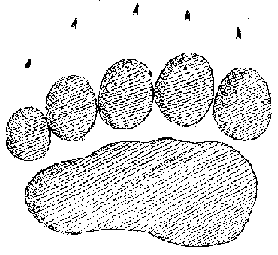
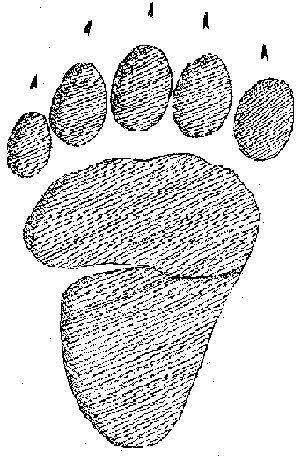
Black Bear Tracks
Front track on the left. Hind track on the right. Claw marks do not always show.
Click here to hear a bear roar. (48K WAV)


![]() Natural History of Black Bears
Natural History of Black Bears ![]()
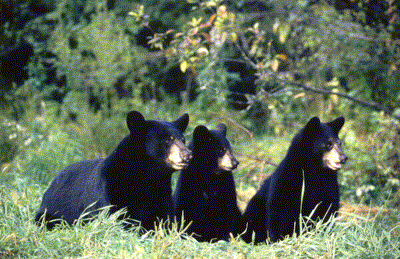
Black bears are the smallest American bears, and the most common. They are the only bears found in the wild in California. Although the grizzly bear is the state mammal, it has been extinct in California since 1922.
Black bears are usually nocturnal, but can be active during the day. Bears are strong, agile, and quick. They swim and climb trees well. A bear can run 30 miles per hour in short bursts.
Bears eat a wide variety of foods. A partial list includes: grass, leaves, nuts, berries, buds, twigs, roots, corn, fruits, insects, plant sprouts, invertebrates, fish, carrion, fruit, succulent plants, eggs, birds, small mammals, and human garbage. Bears will dig up underground wasp nests to eat the insects, nest and all. They are extremely hungry when they emerge from their winter dormancy period in the spring and will often strip the bark off trees to eat the sugary cambium layer. The bears in the region do not hibernate all winter, but they do sleep away the harshest part of winter. Bears den in logs, beneath fallen trees, and in caves. Several days before entering the den, a bear consumes roughage, including leaves and bits of its own hair. These form a plug up to a foot long in the digestive system that is voided after the bear emerges from the den.
One or two young are born during the winter, usually in January or February. They weigh Ĺ pound at birth and grow quickly by nursing on the mother's milk, which can contain as much as 20% fat.
Bear droppings are over an inch thick, and tubular. The scat varies with diet, which can be 90% vegetable matter.
Bears are shy animals and will usually run from humans. They sometimes raid human garbage, compost piles, or pet food dishes that are left outside.
The inner toe in the track is the smallest toe. Bears walk plantigrade or flat-footed. Bears use the same trails over and over for generations. They tend to place their feet in exactly the same place every time they use the trail. You can find these trails where each footfall is in a depression worn into the ground by the passage of so many bears over the years.


![]() Personal Notes on Black Bears
Personal Notes on Black Bears ![]()
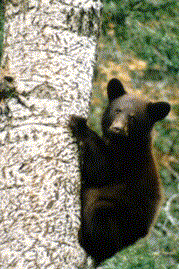
I never lived in bear country until about seven years ago, when I moved to northern California. Black bears are abundant here. No grizzlies live in California (except in zoos). The last California grizzly was shot in 1922 in Tulare County. In Humboldt County, where I live, the first explorers through the area encountered numerous grizzlies as they made their way south. This was in late 1849 and early 1850. In fact, one of the explorers was attacked by a grizzly near the present-day town of Miranda.
I have seen several black bears close up. One was raiding my garbage cans one night. I heard noise outside and opened the door to see what it was. I startled the bear, who ran about 50 feet, then climbed up a tree and clung there, looking at me and grunting. I went back inside to watch what it would do. It climbed down from the tree and cautiously approached the garbage again. I flung open the door and the bear took off running. (Donít try this at home.)
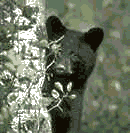
The next bear I saw was a young one that had developed a taste for food from campsites that were unoccupied. (This happened in the park where I work summers.) I was working in the campground entrance one day when two guys came up and told me theyíd seen a bear about 50 feet down the road. I went to look and, sure enough, there was the little bear. He stood still, thinking I hadnít seen him. When I began to move down the road, he took off running for the brush. He stopped after a short distance and put his paws up on a tree as if to climb. When he realized I wasnít following him, he sauntered off into the brush.
This same bear gave me an entertaining summer following his trails around the campground. Bears are fairly habitual and will stick around an area where there is easy food. This one decided that he liked the sort of foods people bring camping. He established a network of trails all the way around the campground perimeter, just out of sight. Heíd keep himself hidden in the thick brush or up on an abandoned road that ran up a hill behind the camp. When someone left food out in a campsite, he would scurry down and grab it and cart it back up the hill, where he ate the prize.
His trail system provided him a highway between two campgrounds and some of his favorite resting areas. The best bear day bed that Iíve ever found was one this bear used. It was an old apple tree, overgrown with blackberry vines, and surrounded by brush and grass. The tree had a large, horizontal limb that provided the bear with a hammock in which to lounge away the warm summer days while he nibbled apples from the tree, or berries from the vines. The creek ran not 20 yards from the bearís hangout, providing fresh water anytime. It was the perfect bear hangout. It has been used several years in a row now.
I find bears challenging to track because their feet are relatively flat. They walk plantigrade, or flat-footed. You would think that such a large animal would leave huge imprints. Actually, they donít. Most of the time, the tracks I find are indistinct flattenings of the soil. Every once in a while, I find a nice clear print showing all five toes and maybe the claws. Usually the claw marks are not visible. And, sometimes, the fifth toe doesnít make an imprint. Tracking bears is like tracking barefoot humans. There are no sharp edges on the feet to leave distinct impressions on the ground.
Iíve made plaster casts from numerous bear tracks. Recently, I made a cast of a print in fine river silt. The cast shows the hair on the foot!
Bears are intelligent animals and their trails will yield endless hours of entertainment, if you are willing to spend the time. Youíll learn a lot about bears just by following their tracks. Itís time well spent.
Find bear and bear track posters, greeting cards, t-shirts, hats, and more in my new store.
|
Now available: "Animals Don't Cover
Their Tracks - An Introduction to Animal Tracking" on CD! (Version 3.0)
New drawings, more species, more photos, more extensive sections on tracking
humans, more detailed directions for plaster casting, mystery tracks section,
tracking stories section, and more. The CD features over 100 species, including
special bonus sections with the tracks of some African and Australian
animals. A large section on tracking lost people for search and rescue is
included, with over four pages of photos showing the details of tracks and
signs people leave. Easy to use format. This web site is limited
by bandwidth, but the CD-ROM is not. The CD is available in my online store at:
www.dirt-time.com
Works with Mac or PC. Happy tracking!!
What else can you find in the nature store? Beartracker's animal tracks coloring book, T-shirts, sweatshirts, journals, book bags, toddler and infant apparel, mouse pads, posters, postcards, coffee mugs, travel mugs, clocks, Frisbees, bumper stickers, hats, stickers, and many more items. All with tracks or paw prints, or nature scenes. Custom products are available. If you don't see the track you want on the product you want, email me and I can probably create it. Proceeds from all sales go to pay the monthly fees for this web site. You can help support this site as well as get great tracking products! Thank you! |
| Find other tracking products: www.zazzle.com/tracker8459* |
| Also visit these fine
stores for more products of interest: NDN Pride shop - For Indian Pride items for all tribes. Custom items available on request. ASL Signs of Love - For anyone who uses or is learning ASL, American Sign Language. Custom name items and more are available here. Sales from all stores give commissions to Beartracker's Animal Tracks Den, which helps keep this site online as a free service. We are celebrating ten years online this year! |




Got a bear story? E-mail me and tell me about it.
Copyright © 1998-2007. Text and drawings by Kim A. Cabrera
Bear pictures from The Bear Den

